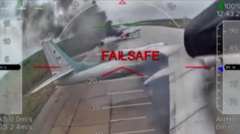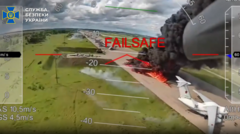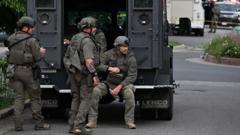As Ukraine's drone strikes penetrate Russian territory, military experts signal the need for NATO to reassess its defenses against evolving forms of conflict.
New Era of Warfare: Drone Attacks Reshape Conflict in Ukraine and Russia

New Era of Warfare: Drone Attacks Reshape Conflict in Ukraine and Russia
Drones are proving to be a game-changer in modern warfare, challenging NATO to adapt its strategies to this new threat.
In recent weeks, the drone warfare landscape over Ukraine and Russia has revealed pressing vulnerabilities for major military powers and foreshadowed a transformative shift in contemporary combat. This communication revolution, highlighted by Ukraine's audacious use of drones to target Russian air bases, brings to light NATO's unpreparedness to contend with this new form of warfare. On Sunday, Ukraine conducted a landmark operation involving hundreds of drones, successfully damaging or eliminating up to 20 crucial aircraft located at distant air bases within Russia.
The implications of these strikes have sent defense officials across NATO member states into a state of urgent reassessment, as they grapple with the reality that their air bases could also be at risk of similar attacks from adversaries utilizing drone technology. "This incident underscores a significant change in the character of warfare, where conventional front lines may become obsolete," noted James Patton Rogers, a drone warfare expert from Cornell University. He emphasized the necessity for NATO to evaluate the potential vulnerabilities present within its own critical infrastructure, including air bases and bombers.
This newfound urgency coincides with a period in which Russia has ramped up its long-range drone strikes targeting both military and civilian entities within Ukraine, illustrating its capacity to deploy numerous unmanned aircraft almost as swiftly as they can be produced. In stark contrast, defense manufacturers in the U.S. and Europe have found themselves struggling to boost weapon production over the past three years to meet the evolving demands of the war.
Recognizing the immediate need for adaptation, NATO has initiated collaborative training efforts with Ukrainian forces earlier this year in Poland, aspiring to extract significant lessons from Russia's ongoing invasion. With the Ukrainian military being the largest and most battle-hardened in Europe—aside from Russia—its experiences provide invaluable insights into modern combat tactics, despite the ongoing challenges faced in maintaining territorial integrity along its borders.
The implications of these strikes have sent defense officials across NATO member states into a state of urgent reassessment, as they grapple with the reality that their air bases could also be at risk of similar attacks from adversaries utilizing drone technology. "This incident underscores a significant change in the character of warfare, where conventional front lines may become obsolete," noted James Patton Rogers, a drone warfare expert from Cornell University. He emphasized the necessity for NATO to evaluate the potential vulnerabilities present within its own critical infrastructure, including air bases and bombers.
This newfound urgency coincides with a period in which Russia has ramped up its long-range drone strikes targeting both military and civilian entities within Ukraine, illustrating its capacity to deploy numerous unmanned aircraft almost as swiftly as they can be produced. In stark contrast, defense manufacturers in the U.S. and Europe have found themselves struggling to boost weapon production over the past three years to meet the evolving demands of the war.
Recognizing the immediate need for adaptation, NATO has initiated collaborative training efforts with Ukrainian forces earlier this year in Poland, aspiring to extract significant lessons from Russia's ongoing invasion. With the Ukrainian military being the largest and most battle-hardened in Europe—aside from Russia—its experiences provide invaluable insights into modern combat tactics, despite the ongoing challenges faced in maintaining territorial integrity along its borders.























